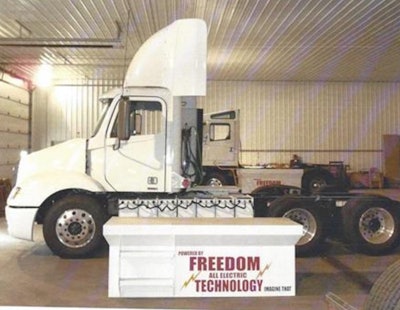 This is a photo that accompanied a press release from Oakridge Global Energy Solutions which states that it will be building batteries for a class 8 electric truck that is expected to have a range of 400 miles or more.
This is a photo that accompanied a press release from Oakridge Global Energy Solutions which states that it will be building batteries for a class 8 electric truck that is expected to have a range of 400 miles or more.“Hi. This is Tom Quimby with Hard Working Trucks. I’m calling about—“
“Let me save you some time. Are you calling about the Oakridge electric truck?” the man asked.
“Yes.”
“It doesn’t exist.” And then the line went dead. End of conversation.
That abrupt and intriguing phone call started it all…a short, but very telling look into whether Freedom Trucking’s class 8 electric truck with a reported 400-mile range actually exists.
Having test-driven Mitsubishi Fuso’s class 6 electric truck recently in Indianapolis, I was impressed with its quiet, quick power, but concerned—along with everyone else—about its lackluster 60-mile range.
One of Mitsubishi Fuso’s engineers confirmed once again that current battery technology limits driving range. That, or they can pile on nothing but batteries, travel a lot farther and sacrifice so much payload that they’re stuck delivering foam pillows and corn flakes.
HWT Related: Test Drive: Mitsubishi Fuso Canter all electric truck
But then came the thought of those batteries from Oakridge Global Energy Solution. In the midst of an admirable venture into reshoring, the small Florida start-up reported that it would be building batteries in the Sunshine State that would provide an impressive 400-mile driving range for class 8 electric trucks owned by Freedom Trucking in Minnesota.
An excerpt from the Oakridge press release states:
Freedom Trucking has developed a fully electric interstate truck propulsion system that will immediately enable interstate trucks with a gross vehicle weight of 80,000 pounds to travel more than 400 miles.
Steve Barber, Oakridge executive chairman and CEO, piqued my interest even more when, a little further into the press release, he talked about Oakridge’s batteries.
“The custom battery design for Freedom Trucking is an absolute game changer,” said Oakridge Executive Chairman and CEO, Steve Barber. “We are excited to be working with Freedom Trucking and their team on such a revolutionary product.”
The press release goes on to say that the truck’s propulsion system “has been hampered by poor quality Chinese batteries, but is now ready for full scale production in 2016 with high quality, ‘Made in USA’ Oakridge battery systems.”
Oakridge states that the electric trucks will be on the highway this year, transporting goods regularly between Chicago and Minneapolis.
Naturally, I contacted Oakridge with the thought of learning more about their batteries. Just how revolutionary were they? Were they working with other trucking companies?
While waiting on Oakridge to respond to my email and voicemails (a month later, and still nothing), I reached out to Freedom Trucking.
Well, you saw how that conversation went. A man answering a number for Freedom Trucking in Minnesota cut me off mid-sentence and said that the truck didn’t exist.
Okay, that’s catnip for a reporter, and true, maybe the guy on the other end of the phone knows that. Electric trucks, with their Star Wars meets X-Files kind of allure, are already intriguing enough. But now, on top of that, Freedom Trucking is reporting that the truck doesn’t exist and Oakridge won’t get back to me (or others, as it turns out). At this point, I’ve got one potential source left on the press release: Ohio State University, which Oakridge credits for developing the technology for the elusive truck.
However, before calling OSU, I called my boss, Jason Cannon, equipment editor for Equipment World and Commercial Carrier Journal, to run the whole thing past him. He found out some things that proved interesting. Bottom line: others were also having trouble confirming the truck’s existence.
Cannon said to give Ohio State a call, which I did.
Two sources at OSU said the truck has been around since 2008. One verified that Freedom Trucking is the current owner.
OSU’s chief designer at the Center for Automotive Research, Dr. Codrin-Gruie Cantemir, told me that the class 8 vehicle can go beyond a 400-mile range; however, with those longer ranges, he said, comes the same old problem of payload capacity and weight restrictions.
Cantemir could not confirm or deny if the batteries at Oakridge were, in fact, “a game changer,” as Barber states. He said that the university, after having built the truck and passed it along to its current owner, Richard Olson, is now in more of an advisory role.
Cantemir said he had recently talked with Olson, former owner of Fil-Mor Trucking, about the truck.
Some more digging revealed that the truck is currently undergoing testing. Eventually, I was able to get in touch with Olson, who, while polite, said he would not be granting any interviews, at least not yet.
“There’s a great deal of witchcraft connected with electric trucks,” said Olson, a Minnesota resident. “I’m not ready to make any kind of announcements about it. We have a marketing plan, but I return all my calls. I’m not just picking on you, but at this time, we’re just not giving out any type of interview. People are generally looking for what our secrets are.”
But here’s where it gets strange again: Olson said that while he’s familiar with Oakridge, he’s never heard of Freedom Trucking and he said he’s not working with Ohio State.
Take that for what’s it’s worth. For me, it’s a reminder that finding the right degree of media exposure between exciting R&D and an actual product reveal can be very challenging, especially when various entities are involved and they’re not all using the same playbook.









